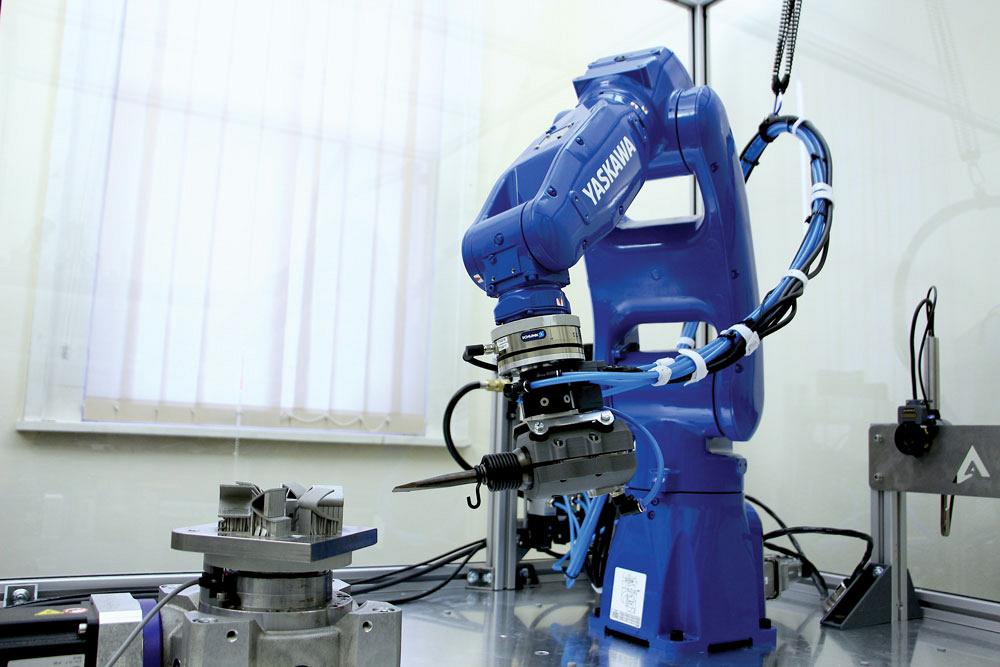Founder/CEO
- FMA
- The Fabricator
- FABTECH
- Canadian Metalworking
Robotic finishing with no-code programming aids metal finishers
Finish better by breaking down barriers
- By Robert Bush
- March 16, 2022
- Article
- Metalworking

Advanced software interfaces, sensors, and controllers make it possible to quickly and easily program industrial robots with high dexterity, bridging human creativity with machine accuracy. Rivelin Robotics
For hundreds of years metalworkers used skilled, manual, labour-intensive, and hazardous techniques for metal finishing. Today software empowers modern metalworkers to easily train industrial robots to perform these tasks and transfer their skill and experience into digital metalworking recipes without the need for computer code.
There are challenges, especially when automating metalworking tasks that require sharp eyes, a soft touch, and nimble fingers. Problems with quality, high costs, and unfilled jobs often prevent manufacturers from using technologies like additive manufacturing (AM) and casting in their production lines.
While they know they must break from the past to build for the future, the question is how to overcome the barriers that exist. These barriers include:
1. Labour Shortages. Post-processing is a necessary element of near-net-shape manufacturing, but it is skilled, noisy, dusty, and strenuous work. Those with the necessary skills are approaching retirement age, and the younger generation typically isn’t willing to replace them.
2. Repeatability. The toughest job in post-processing is finish metalworking. It takes decades of training and dedication to achieve the accuracy modern industry demands. Naturally, there are variations between metalworkers, and this risk is complex and costly to manage at production scales.
3. Cost Competitiveness. The business case for near-net-shape manufacturing versus subtractive manufacturing often is on a knife’s edge. Post-processing of near-net-shape parts commonly costs more than the manufacturing process itself. This is because of the manual and time-consuming processes such as support removal, gate and runner removal, deflashing, deburring, depowdering, witness removal, finishing, polishing, and inspection.
4. Sustainability. Near-net-shape manufacturing is one of the technologies that can help us achieve a net-zero carbon economy. Efforts need to be focused on reducing the scrap rate and energy waste throughout the entire manufacturing process from raw materials to finished parts.
Industry must turn to digital manufacturing and robotics, but the good news is that the technology already exists to make the transition seamless and cost-effective.
Challenges of Intelligent Automation
Conventional industrial robots can take a long time to program. It also can be expensive and time-consuming to commission a robotic cell. To make things worse, rigid machine tools don’t cope with the inherent variability and freeform complexity of printed and cast components very well.
However, advanced software interfaces, sensors, and controllers make it possible to quickly and easily program industrial robots with human dexterity, bridging human creativity with machine accuracy. They just need the right “senses.”
Sense of Sight. A metalworking robot needs to account for part variability. 3D snapshot sensors autonomously scan and align physical components with the CAD output, giving feedback on part geometry and enabling flexible fixturing.
Sense of Touch. A metalworking robot must allow for unknown surface topologies. Force sensors combined with grinding-specific force control algorithms can give feedback on high/low spots and adapt the required number of tool passes.
Sense of Hearing. A metalworking robot should continuously monitor tool wear. With low-cost microphones and break-beam sensors, it is now possible to ensure repeatable surface finish and maximize tools’ useful life.
Sense of Direction. An engineer or technician with no prior robotics experience needs to be able to quickly create metalworking recipes using their experience, knowledge, and intuition. Metalworking robots that can be taught with a no-code programming interface permit rapid reconfiguration without the services of expensive system integrators.
Transforming an Industry
Adaptable automation is critical when parts are subject to variability within and between batches. Metal AM and die casting are two examples of this.
Eliminating the witnesses left behind by gates and risers is a challenging step that is complicated further by die wear over time. Conventional automation does not adapt to these changes and can result in non-conforming parts and worn or broken machine tools.
Die casting also often leaves witness lines on components as a necessary side effect of mold design. As molds wear, the position and extent of flashing and parting lines change. Conventional automation does not adapt to these changes, causing inconsistencies between early and late production and sometimes resulting in non-conforming parts. Unexpected material also can cause excessive tool wear, further adding to the costs of rigid automation methods.
Metal AM requires support structures to prevent sagging and deformation of overhanging geometries during the build processes. Support removal is the most labour-intensive part of AM post-processing. When accounting for surface witness removal, it can make up to 25 per cent of total part cost. This skilled, hazardous, and unpleasant manual task requires years to perfect and results in variability between parts and from worker to worker.
AM components often exhibit high surface roughness and visible layers. Parts that require localized polishing typically are finished by hand or in a rigid machine tool. Both methods are expensive and suffer from quality issues because of the surface variability often found in AM parts. Manual polishing varies over time and from worker to worker, leading to unacceptable inconsistencies in production.
An intelligent automation platform for metalworking equipped with sensors for vision, sound, and touch has the potential to address each of these challenges and complete the digitalization of near-net-shape manufacturing.
Find a partner that can capture metalworking skill and intuition and translate it into safe and repeatable robot instructions for your finishing needs.
Robert Bush is founder/CEO of Rivelin Robotics, Unit 37, New Mesters, 53 Mowbray St., Sheffield, England S3 8EN, www.rivelinrobotics.com.
About the Author
subscribe now


Keep up to date with the latest news, events, and technology for all things metal from our pair of monthly magazines written specifically for Canadian manufacturers!
Start Your Free Subscription- Trending Articles
Automating additive manufacturing

CTMA launches another round of Career-Ready program

Collet chuck provides accuracy in small diameter cutting

Sandvik Coromant hosts workforce development event empowering young women in manufacturing

GF Machining Solutions names managing director and head of market region North and Central Americas

- Industry Events
MME Winnipeg
- April 30, 2024
- Winnipeg, ON Canada
CTMA Economic Uncertainty: Helping You Navigate Windsor Seminar
- April 30, 2024
- Windsor, ON Canada
CTMA Economic Uncertainty: Helping You Navigate Kitchener Seminar
- May 2, 2024
- Kitchener, ON Canada
Automate 2024
- May 6 - 9, 2024
- Chicago, IL
ANCA Open House
- May 7 - 8, 2024
- Wixom, MI















